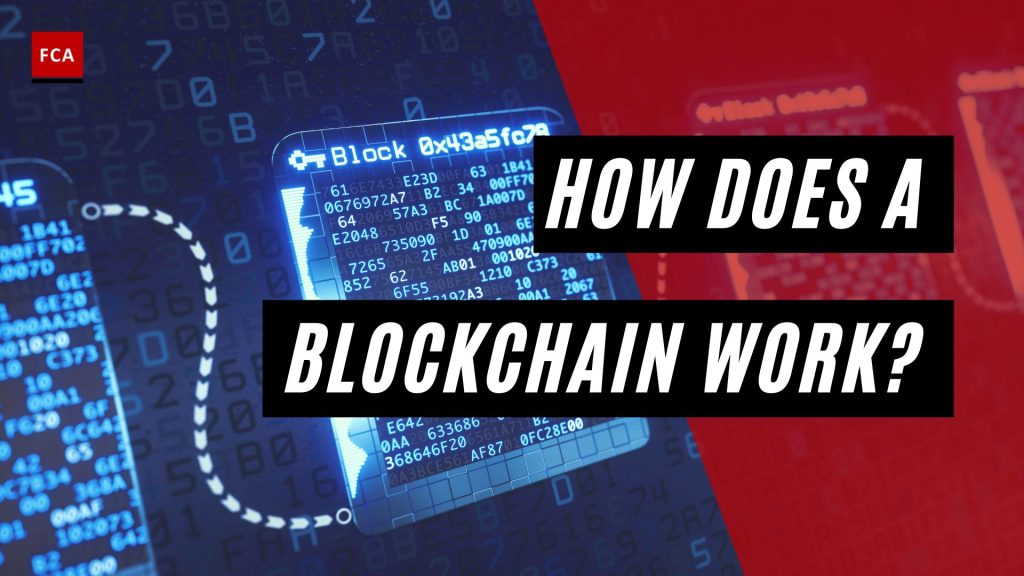How does a Blockchain work? Blockchain technology is praised by experts due to its security and the fact that blockchain technology is decentralized which makes it more secure. This is because there is no central point of control and failure. Hackers would not find it easy to attack because every node in the network shall be required to be attacked to tamper with the data.
Blockchain technology is secure because of the way the data is stored in a traditional database, the information is stored in a single location which is a limitation and leads to hackers getting access easily to the confidential information. However, the data is spread across the network with blockchain technology, making it more protected from tampering. Unless the availability of more powerful computers is ensured, any attempts to manipulate the data will automatically be dismissed. This is the reason which makes the blockchain unchangeable.

How does a Blockchain Work?
One of the most promising aspects of blockchain technology is its ability to create a trustless system. In a trustless system, two parties can interact without the need for a third party to mediate the transaction. This system could potentially reduce the cost of doing business and make it easier to conduct transactions online. Another potential use of blockchain technology is in the domain of data security. For example, users can use blockchain technology to create a decentralized database that is secure and free from hacks or data breaches.
So essentially, the Blockchain can be thought of as a distributed database. Additions to this database are initiated by one of the members, which are the network nodes. These nodes usually exist in the form of computers. Each node maintains a copy of the entire Blockchain.
The nodes also create new blocks of data, which can contain all sorts of information. Among other information, the block contains a hash. A hash is a string of numbers and letters and each new block generates a hash. The hash does not only depend on the block itself but also on the previous block’s hash. This is one of the reasons why the order of the blocks matters and why blocks are added to the Blockchain in the order that they occurred. Even a small change in a block creates a completely new hash.
After its creation, a new block is broadcasted to every party in the network in an encrypted form so that the transaction details are protected. The nodes of the network check the validity of each new block that is added. Once a block reaches a certain number of approved transactions then a new block is formed. The determination of the block’s validity happens following a pre-defined algorithmic validation method. This is commonly referred to as a “consensus mechanism”. The nodes check the hash of a block to make sure a block has not been changed.
Once validated, the new “block” is added to the blockchain. As soon as the nodes have approved the new Block, the Blockchain or ledger is updated with it, and it can no longer be changed or removed. It is therefore considered to be impossible to forge it. You can only add new entries to it and the registry is updated on all computers on the network at the same time.

The blocks are also signed with a digital signature using a private key. Every user on a blockchain network has a set of two keys: Firstly, A private key, which is used to create a digital signature for a block, And secondly, A Public key, which is known to everyone on the network. A public key has two uses. On the one hand, it serves as an address on the blockchain network. On another hand, it is used to verify a digital signature and validate the identity of the sender.
A user’s public and private keys are kept in a digital wallet or e-wallet. Such wallets can be stored or saved online and offline. Online storage is often referred to as hot storage and offline storage is commonly referred to as cold storage.
Final Thoughts
Blockchain is a decentralized digital ledger that records transactions across a network of computers. It is secured through a consensus mechanism that requires significant computational power to add a new block to the chain. Once a block has been added to the chain, it cannot be altered without invalidating the entire chain, creating a high degree of immutability. The benefits of blockchain technology include trustless transactions, increased security, and reduced potential for fraud and corruption. As the technology continues to evolve, it has the potential to transform industries and create new opportunities for innovation.








